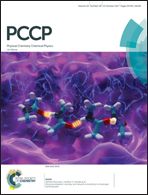Mechanism of C–C and C–H bond cleavage in ethanol oxidation reaction on Cu2O(111): a DFT-D and DFT+U study
Abstract
The performance of transition metal catalysts for ethanol oxidation reaction (EOR) in direct ethanol fuel cells (DEFCs) may be greatly affected by their oxidation. However, the specific effect and catalytic mechanism for EOR of transition metal oxides are still unclear and deserve in-depth exploitation. Copper as a potential anode catalyst can be easily oxidized in air. Thus, in this study, we investigated C–C and C–H bond cleavage reactions of CHxCO (x = 1, 2, 3) species in EOR on Cu2O(111) using PBE+U calculations, as well as the specific effect of +U correction on the process of adsorption and reaction on Cu2O(111). It was revealed that the catalytic performance of Cu2O(111) for EOR was restrained compared with that of Cu(100). Except for the C–H cleavage of CH2CO, all the reaction barriers for C–C and C–H cleavage were higher than those on Cu(100). The most probable pathway for CH3CO to CHCO on Cu2O(111) was the continuous dehydrogenation reaction. Besides, the barrier for C–C bond cleavage increased due to the loss of H atoms in the intermediate. Moreover, by the comparison of the traditional GGA/PBE method and the PBE+U method, it could be concluded that C–C cleavage barriers would be underestimated without +U correction, while C–H cleavage barriers would be overestimated. +U correction was proved to be necessary, and the reaction barriers and the values of the Hubbard U parameter had a proper linear relationship.



 Please wait while we load your content...
Please wait while we load your content...